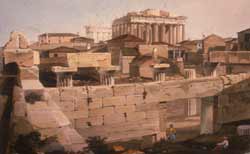Ruins
Standing remains - ruins like Stonehenge or ghost towns - have always been crucial to archaeology because they constitute conspicuous, durable reminders that people before our own time have lived in the landscape that we see before us now. Ancient examples are usually monuments built of stone which have survived, sometimes remodelled and re-used for very different purposes.
The Parthenon at Athens is a good example. Built on the Akropolis in the fifth century BC, it was the main temple of the goddess Athena in the ancient city. After antiquity, Athens dwindled in importance, though it was never entirely deserted. The Parthenon was re-used as a church probably in the fifth century AD, and later still, a small mosque was built inside it.
 Athens: Akropolis from Propylaia, painted by Edward Dodwell (1819). |
The British artist and traveller Edward Dodwell painted this view of the Akropolis in the early years of the nineteenth century AD, when Athens was still a small village, and about 30 years before it became the capital of the modern Greek state after the Greek War of Independence.
The painting shows the Parthenon surrounded by smaller, later houses constructed of very different materials. The Parthenon was ruined, but still very obviously different and older, compared to the houses. When people like Dodwell began to visit Greek lands to see what the temples of ancient Greece looked like, it was not hard for them to recognise the Parthenon for what it was. (We examine in further detail the 'rediscovery' of Greece in Unit 2 Session 1.)
 (Click to enlarge) © Thames and Hudson |
Ruins are particularly useful when they mark the location of settlements that are now deserted. This second example is an aerial photograph of one part of ancient Gortyn in south-central Crete.
Two structures are clearly visible - the east end of the church of Agios Titos constructed in the sixth-seventh century AD; and the semi-circular Odeion or music hall, dating to the Roman period. The aerial photograph also reveals traces of a structure that did not survive so well - an ancient theatre to the south of the Odeion.
It was the ruins of the church, and the presence of inscribed blocks (part of the Odeion) that helped early archaeologists on Crete to identify the site of Gortyn, where modern study began in 1884 (for more details, see Unit 3 Session 2).
Aerial photography is one of many techniques now available to detect and record monuments and other traces of human activity in the landscape. Remote sensing is also of great value to archaeologists. Canada Centre for Remote Sensing's Web site offers an excellent introduction to the subject, and includes a free tutorial entitled 'Fundamentals of Remote Sensing'.
Canada Centre for Remote Sensing Web site